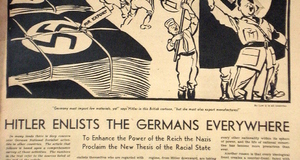From Elon Journal of Undergraduate Research in Communications VOL. 5 NO. 2From "Pockets of Poverty" to Potential Prosperity in Appalachia: Examining Mass Media Narratives of Poverty Stereotypes in AppalachiaDiscussion and ConclusionsTo address the research question of how local media visualize and frame issues of poverty in Appalachia compared to national media, in the January 1964 coverage, the national media were more likely to focus on economic issues, which also meant the national media used primarily negative language when describing conditions in Appalachia, while the local media used primarily positive language. In this regard, the hypothesis that local media and community members are more likely to use positive language and visuals than national media was partially correct. However, there was a shift in the January 2014 media coverage where the local media used negative language and the national media used mostly positive language, focusing on the progress in the Appalachian region. This change correlated with the findings that the national media provided equal coverage of political, economic, and social issues in the January 2014 media coding, which did not support the hypothesis that national media would focus primarily on economic issues rather than social and cultural topics. In the January 2014 media analysis, the top three themes identified in The Mountain Eagle were children/youth, education, and family, and the top three themes identified in The New York Times were children/youth, education, and unemployment. It is interesting to note that the national media articles that focused on social or cultural topics were more likely to use positive language, while those focused solely on structural or economic topics were more likely to use negative language to depict poverty. There was only one article related to the War on Poverty in The Mountain Eagle in January 2014 and one article in February 2014. The single comment issued by the newspaper in February mentioned this year marked the 50th anniversary of the War on Poverty, and reposted an editorial that appeared in 1964 as nations and reporters turned their cameras toward Eastern Kentucky (2014, p. A1). The editorial encouraged community members to welcome assistance and publicity from outsiders to show the necessity for the War on Poverty and increase federal aid, citing the Tennessee Valley Authority, which was brought in response to the attention from magazines and newspapers, as an example of how other organizations can help Whitesburg (2014, p. A1). The editorial said the reaction against outsiders reached a climax when two county officials threatened to put a group of British television reporters and photographers in jail if they took more pictures of what they considered to be poverty. However, it countered popular opinion by saying: We have seen hardened reporters and photographers, those who have seen conditions all over the world, with tears in their eyes as they told us of some of the living conditions they had seen in Letcher County. Without exception, the ones to whom we have talked have been fired with desire to do something to help. And they do the thing they know how to best—they show in words and pictures the disgraceful and heartbreaking way many Letcher County residents have to live. This they do in an effort to convince other Americans who live in far better circumstances that their duty is to see that things are bettered here. (2014, p. A1) Although the editorial was a rare voice in 1964 because it encouraged outside journalists to cover topics of poverty in the area and criticized the negative reactions from Letcher County to the War on Poverty, which varied “only in the intensity of their condemnation,” it seems its opinion is a narrative that is becoming increasingly popular in Appalachia today. The Mountain Eagle’s decision to repost this editorial attests to the potential changing nature of using community voices to discuss why previous federal and state efforts have failed, and how better moral and ethical efforts can be made in the future through a change in the language and framing of the region. The observations suggest recommendations that national journalists use findings from local organizations that gather information on attitudes and practices around the target issues so that they can understand the issues identified directly by citizens from local areas. The difference in the representations of Appalachia by the local media and the national media suggests a potential need for greater communication between the people and the organizations representing the people. LimitationsThe first limitation in the local and national media analysis is that only two specific newspapers were analyzed, which do not represent the differences in overall local and national perspectives. This research would have also benefited from incorporating data from a longer period of time so that the patterns observed in a higher number of articles coded in the media analysis could represent a larger perspective. Additionally, many of the articles in the media analysis were editorials, which can be considered a limitation because the view of the author does not fully represent the overall stance of The New York Times or The Mountain Eagle. However, because of the limited number of available, relevant articles, it was important to include the content from the editorials and opinion pages. Likewise, there was only one article in The Mountain Eagle for the January 2014 coding, compared to nine articles in The New York Times. While this proportion is less balanced than the January 1964, which had 11 articles from The New York Times and 12 articles from The Mountain Eagle, the lack of coverage on the 50th anniversary of the War on Poverty, perhaps, echoes the local media’s being fatigued from the extensive national media attention to the region. For the media analysis, another coder was not employed, so the article is vulnerable to the subjectivity. For the coding, two separate coding sheets were used rather than one consistent coding sheet—while the basic coding categories were the same, separate coding sheets were adapted to accommodate the emergent themes that appeared in the separate media narratives. AcknowledgementsThe author would like to extend thanks to Dr. Kenn Gaither at Elon University for being the first person to point out she lit up every time she talked about Appalachia and for his kind patience, constant encouragement, and invaluable guidance. The author is also thankful to Dr. David Copeland at Elon University for his supervision and advice. Finally, the author appreciates the support from Elon University’s Honors Fellows program and her parents. References(2012). In U.S. Census Bureau. Retrieved March 1, 2014, from http://www.census.gov/ Bailey, M. J. (2014, January 5). Why we need one. The New York Times, p. 3A-12A. Barrouquere, B. (2014, January 15). Food stamp cuts hitting Kentucky county hard. The Mountain Eagle, p. 1A-4A. Bernstein, J. (2014, January 6). The War on poverty at 50. The New York Times, p. 1A- 4A. Bigart, H. (1964, January 6). Appalachia, nation’s worst pocket of poverty, awaits decision on 5-year program. The New York Times, p. 1A-2A. Bigart, H. (1964, January 13). Poverty blights iron ore region of the Midwest. The New York Times, p. 1A-22A. Bornstein, D. (2014, January 8). In the long war on poverty, small victories that matter. The New York Times, p. A1-A7. Bowler, B. M. (1985). That ribbon of social neglect. Appalachian Journal, 12(3), 239- 247. Chinitz, B. (1964, January 6). Appalachian plan defended. The New York Times, p. A1. Cooper, C., Knotts, G., & Livingston, D. (2010). Appalachian identity and policy opinions. Journal of Appalachian Studies, 16(1/2), 26-41. Creswell, J. W. (1998). Qualitative inquiry and research design: choosing among the five traditions. Thousand Oaks, CA: Sage. Editorial from 1964: ‘How Many Times’. (2014, February 12). The Mountain Eagle, p. A1. Eleven Schools to Get Lunch Program Monday. (1964, January 30). The Mountain Eagle, 56(38), p. 4A. Entman, Robert M. 1993. Framing: toward clarification of a fractured paradigm. Journal of Communication, 43(4): 51-8. Fairhurst, G. & Star, R. (1996). The Art of framing: managing the language of leadership. San Francisco: Jossey-Bass Publishers. Ferrence, M. (2012). You are and you ain’t: Story and literature as redneck resistance. Journal of Appalachian Studies,18(1/2), 113-130. Gish, T., & Gish, P. (1964, January 2). Will 1964 seal Eastern Kentucky’s fate? The Mountain Eagle, p. A4-A6. Gonchar, M. (2014, January 7). Economic inequality in america: developing a new war on poverty. The New York Times, p. 1A-7A. Gould, J. (1964, December 22). TV review: stark poverty of one million Americans. The New York Times. p. 1A. Harvey, D. L., & Reed, M. H. (1996). The culture of poverty: An ideological analysis. Sociological Perspectives, 39(4), 465-495. Hunter, M. (1964, January 29). South is warned on negro poverty. The New York Times. p. 1A. Iyengar, S. (1991). Is anyone responsible? How television frames political issues. Chicago, IL:University of Chicago Press. Jobless Miners Assured on U.S. Aid to Kentucky. (1964, January 9). The New York Times. p. 1A. Johnson Gives Broad Plan of War on Poverty. (1964, January 23). The Mountain Eagle, 56(37), p. 1A. Kristof, N. (2014, January 8). Progress in the war on poverty. The New York Times, p. A1- A6. Krugman, P. (2014, January 9). The war over poverty. The New York Times, p. A1-A6. Lacan, J. (2004). What Is a picture? The Visual Culture Reader, 126-128. Lett, J., Headland, T. N., & Pike, K. L. (1990). Emics and etics: The insider/outsider debate. Sage. Lowrey, A. (2014, January 4). 50 years later, war on poverty is a mixed bag. The New York Times, p. 1A-6A. Maggard, S. (1983-84). Cultural hegemony: the news media and Appalachia. Appalachian Journal, 11(1/2), 67-83. March, M. S. (1966). Coordination of the war on poverty. Law and Contemporary Problems, 31(1). Massey, C. (2007). Appalachian stereotypes: Cultural history, gender, and sexual rhetoric. Journal of Appalachian Studies,13(1/2), 124-136. Matthews, D. (2014, January 8). Everything you need to know about the war on poverty. The Washington Post. p. 1A. McCombs, M. E., & Shaw, D. L. (1972). The agenda-setting function of mass media. The Public Opinion Quarterly, 36(2), 176-187. Miller, J. M., & Krosnick, J. A. (1996). News media impact on the ingredients of presidential evaluations: a program of research on the priming hypothesis. In D.C. Mutz, P. M. Sniderman & R. A. Brody (Eds.), Political persuasion and attitude change. 9 – 100. Ann Arbor, MI: Michigan University Press. The myth of the kentucky mountaineer. (1964, January 16). The Mountain Eagle, 56(35), p. 4A. On fighting the last war (On Poverty). (2014, January 8). The New York Times, p. 1A-2A. Peters, J. W. (2014, January 8). 2 parties place political focus on inequality. The New York Times, p. 1A-5A. Price, D., Blakeney, R. E., Cain, D., Collins, E. S., & Deal, A. (2000). A camera is a gun: a discussion of “stranger with a camera”. Appalachian Journal, 27(4), 406-417. Price of poverty. (1964, January 3). The New York Times, p. 3A. Robertson, N. (1964, January 12). Mrs. Johnson cheered in ‘poverty pocket’ Coal Towns. The New York Times, p. 1A, p. 42A. Sarnoff, S. (2003). Central Appalachia-still the other america. Journal of Poverty, 7(1/2), 123-139. Scott, R. (2008). The Sociology of coal hollow: safety, othering, and representations of inequality. Journal of Appalachian Studies, 15(1/2), 7-25. Snyder, B. (1982). Image and identity in appalachia. Appalachian Journal, 9(2/3), 124-133. Speer, J. H. (1993). From stereotype to regional hype: Strategies for changing media portrayals of appalachia. Journal of the Appalachian Studies Association, 5, 12-19. Strauss, A., & Corbin, J. (1990). Basics of qualitative research: grounded theory procedures and techniques. Newbury Park, CA: Sage. Tesch, R. (1990). Qualitative research: analysis types and software tools. Routledge. Wang, C. C. (1999). Photovoice: A participatory action research strategy applied to women’s health. Journal of Women’s Health, 8(2), 185-192. The war on poverty, then and now. (2014, January 12). The New York Times, p. 1A, 6A. Wicker, T. (1964, January 9). Johnson State of Union address provides budget of $97.9 Billion, war on poverty, atomic cutback. The New York Times, p. 1A, 17A. Wicker, T. (1964, January 9). Texts of Johnson’s State of the Union message and his earlier press briefing. The New York Times, p. 1A, 17A. Wicker, T. (1964, January 21). Texts of President Johnson’s economic report on the nation’s progress and trends. The New York Times. p. 1A. Will 1964 seal Eastern Kentucky’s fate? (1964, January 16). The Mountain Eagle, 56(36), p. A1, A3. AppendixA: Coding Sheet – War on Poverty (1964)
B: Coding Sheet – 50th Anniversary of the War on Poverty (2014)
C: Coding Results – War on Poverty (1964) Tone and Rhetoric
Characteristics
Functions
Visuals
D: Coding Results – 50th Anniversary of the War on Poverty (2014) Language
Narrative
Characteristics
Function
Topics
Themes
War on Poverty – Success or Failure?
Suggested Reading from Inquiries Journal
Inquiries Journal provides undergraduate and graduate students around the world a platform for the wide dissemination of academic work over a range of core disciplines. Representing the work of students from hundreds of institutions around the globe, Inquiries Journal's large database of academic articles is completely free. Learn more | Blog | Submit Latest in Business & Communications |

















